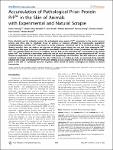Accumulation of Pathological Prion Protein PrPSc in the Skin of Animals with Experimental and Natural Scrapie
Thomzig, Achim
Schulz-Schaeffer, Walter
Wrede, Arne
Wemheuer, Wilhelm
Brenig, Bertram
Kratzel, Christine
Lemmer, Karin
Beekes, Michael
Prion infectivity and its molecular marker, the pathological prion protein PrPSc, accumulate in the central nervous system and often also in lymphoid tissue of animals or humans affected by transmissible spongiform encephalopathies. Recently, PrPSc was found in tissues previously considered not to be invaded by prions (e.g., skeletal muscles). Here, we address the question of whether prions target the skin and show widespread PrPSc deposition in this organ in hamsters perorally or parenterally challenged with scrapie. In hamsters fed with scrapie, PrPSc was detected before the onset of symptoms, but the bulk of skin-associated PrPSc accumulated in the clinical phase. PrPSc was localized in nerve fibres within the skin but not in keratinocytes, and the deposition of PrPSc in skin showed no dependence from the route of infection and lymphotropic dissemination. The data indicated a neurally mediated centrifugal spread of prions to the skin. Furthermore, in a follow-up study, we examined sheep naturally infected with scrapie and detected PrPSc by Western blotting in skin samples from two out of five animals. Our findings point to the skin as a potential reservoir of prions, which should be further investigated in relation to disease transmission.
No license information

